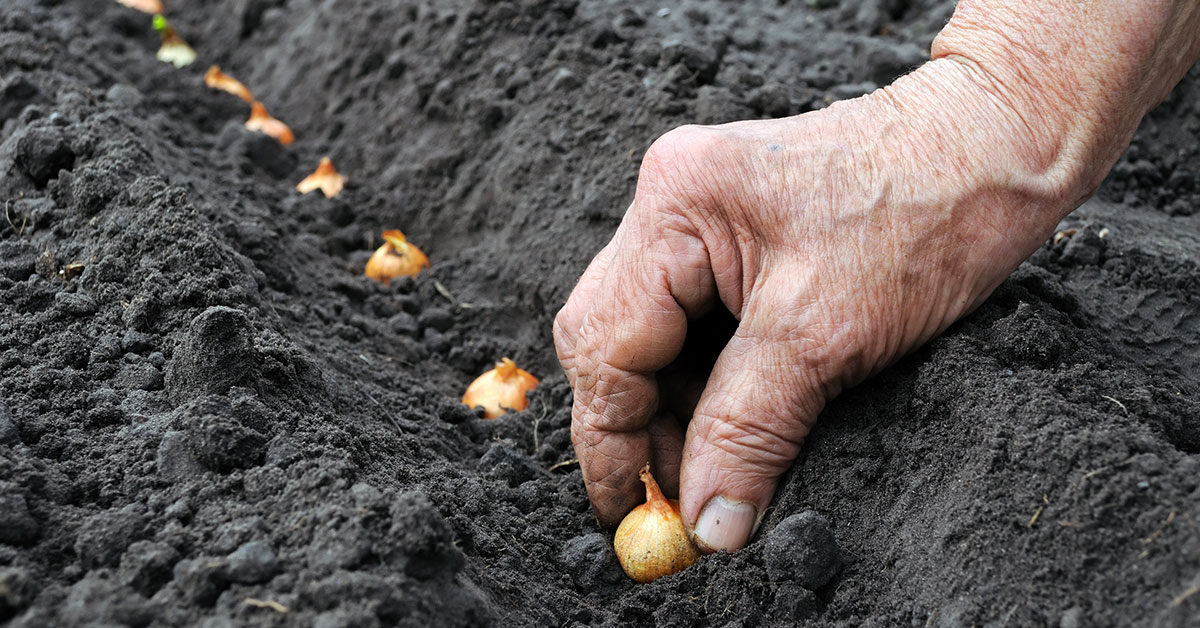Onion cultivation is a popular practice in Virginia due to its suitability for the state’s climate and soil. To maximize the yield and quality of the crop, it’s crucial to plant onions at the right time. Understanding the unique Virginian climates and optimal planting times will lead to more productive growing seasons and larger yields. The approximate planting times vary by location which are broken down below.
Good Onion Varieties to Grow in Virginia
Onions are a popular vegetable crop among gardeners due to their versatility in the kitchen and the ease with which they can be grown. There are numerous varieties of onions, each with its unique characteristics and uses.
Here are some of the more popular onion varieties that gardeners like to grow:
- Red onions: These onions have a beautiful reddish-purple outer layer and a white inner layer. They have a slightly sweet and mild flavor and are often used raw in salads or cooked in stews, soups, and curries.
- Yellow onions: Yellow onions are the most common and versatile variety of onions. They have a papery yellow-brown outer layer and a white inner layer. They have a pungent and slightly sweet flavor and are used in a wide range of dishes, including sautés, stews, soups, and roasts.
- Sweet onions: Sweet onions have a mild and sweet flavor and are perfect for use in raw salads and sandwiches. They have a thin, papery outer layer and a white inner layer. The most famous sweet onion is the Vidalia onion, which is grown in Georgia, USA.
- Shallots: Shallots are small, elongated onions with a brownish-red outer layer and a white inner layer. They have a mild and sweet flavor and are often used in French cuisine. Shallots are excellent in dressings, sauces, and marinades.
- Cipollini onions: Cipollini onions are small, flat onions with a sweet and mild flavor. They have a thin, papery outer layer and are often roasted or caramelized to bring out their natural sweetness.
Overall, each onion variety has its unique flavor profile and culinary uses, making them a popular and versatile crop for gardeners.
When to Plant Onions in Virginia
Onions are a cool-season crop that can be planted in the spring as soon as the soil can be worked. The exact planting time will vary depending on your location and climate, but generally, onions should be planted about 2-4 weeks before the last expected frost date in your area. The onion planting dates in Virginia are:
Additional Resource: Find Your Virginia Hardiness Zone
Before planting onions, it’s essential to prepare the soil by loosening it to a depth of 4-6 inches and incorporating compost or well-rotted manure. Onions prefer well-draining soil with a pH between 6.0-7.0.
To plant onion sets, which are small onion bulbs, make a furrow about 1 inch deep, plant the sets 4-6 inches apart, and cover them with soil. For onion seeds, sow them about 1/4 inch deep and 1 inch apart, and cover them with soil. Water the soil thoroughly after planting, and keep the soil moist until the seedlings emerge.
Onions grow best in full sun and require consistent moisture to produce quality bulbs. They also benefit from regular fertilization throughout the growing season. Weed control is essential, so keep the area around the plants free of weeds.
In conclusion, onions should be planted in the spring, 2-4 weeks before the last expected frost date in your area. Prepare the soil, plant the sets or seeds, water the well, and keep the area free of weeds. With proper care, you can enjoy a bountiful harvest of delicious onions in the summer and fall.
Planting Onions From Seed
Onions can be grown from seed, but it takes longer than planting onion sets or starts. It’s recommended to plant onion starts rather than seeds because onion seeds take a longer time to germinate and grow, and the plants may not mature as uniformly as onion sets.
However, planting onions from seed can be a good option if you want to grow a specific variety that isn’t available as sets or starts. Planting onion seeds can also be more cost-effective than purchasing sets or starts.
If you decide to plant onions from seed, you should start the seeds indoors 8-10 weeks before the last expected frost date in your area. If you decide to plant onions from seed, you should start the seeds indoors 8-10 weeks before the last expected frost date in your area. The final frost dates in Virginia are:
Additional Resource: Find Your Virginia Hardiness Zone
In Virginia, start your onion seeds indoors around:
To start onion seeds indoors, fill seed trays with a good quality seed-starting mix, and sprinkle the seeds on top of the soil. Cover the seeds with a thin layer of soil, water the tray, and keep it in a warm, bright location. Onion seeds need a consistent temperature of 65-75°F to germinate, so you may need to use a heat mat or grow light to maintain the right conditions.
After the seeds have germinated, thin the seedlings to about 1 inch apart, and continue to grow them indoors until they are large enough to transplant outside. Harden off the seedlings by gradually exposing them to outdoor conditions for a week before transplanting them into the garden.
When to Harvest Onions in Virginia
Onions are ready to harvest when the leaves start to turn yellow and fall over. This typically happens in late summer or early fall, about 100-120 days after planting, depending on the variety and growing conditions.
To check if the onions are ready for harvest, gently push back the soil around the base of the onion bulbs to see if they have developed into mature bulbs. If the bulbs are of the desired size, you can start to harvest them.
To harvest onions, use a garden fork or shovel to carefully lift the bulbs out of the soil. Gently loosen the soil around the bulbs to avoid damaging them. Once the bulbs are out of the soil, leave them on the ground for a day or two to dry out and cure in the sun. This will help to toughen the skins and prolong the storage life of the onions.
After the onions have dried and cured for a day or two, cut off the stems and roots to about 1 inch from the bulb. You can then store the onions in a cool, dry place, such as a garage or basement, with good air circulation. Hanging them in mesh bags or tying them in braids is also a good way to store onions.
Onions should be stored in a place with a temperature between 32-40°F and with low humidity. Avoid storing onions near potatoes or other fruits and vegetables that produce ethylene gas, which can cause onions to spoil more quickly.













